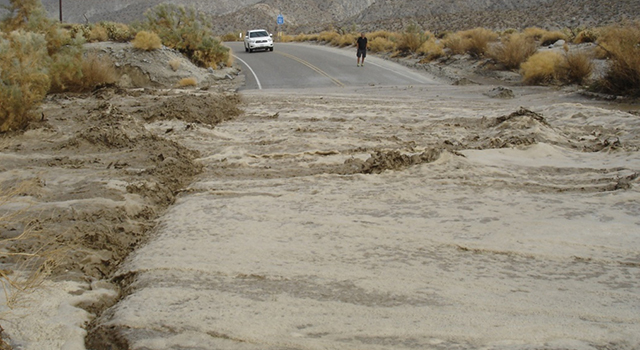Scientists at NASA's Jet Propulsion Laboratory, Pasadena, Calif., and Scripps Institution of Oceanography at UC San Diego have enhanced existing GPS technologies to develop new systems for California and elsewhere to warn of hazards from earthquakes, tsunamis and extreme weather events.
 Flooding across Highway 78, San Diego County, Calif. The NASA/Scripps Institution of Oceanography-developed GPS natural hazards warning system was first used in July 2013 by NOAA National Weather Service offices in San Diego and Oxnard, Calif., to forecast a summer monsoon and issue accurate flash flood warnings. Image credit: NOAA
Flooding across Highway 78, San Diego County, Calif. The NASA/Scripps Institution of Oceanography-developed GPS natural hazards warning system was first used in July 2013 by NOAA National Weather Service offices in San Diego and Oxnard, Calif., to forecast a summer monsoon and issue accurate flash flood warnings. Image credit: NOAA
The technology was demonstrated in July by forecasters at NOAA National Weather Service offices in Oxnard, Calif., and San Diego. They used it to track a summer monsoon rain event affecting Southern California and issue more accurate and timely flash flood warnings. The system uses real-time information from GPS stations upgraded with small, inexpensive seismic and meteorological sensors.
The technology is also being integrated into other real-world cases. One example is making damage assessments for hospitals, bridges and other critical infrastructure that can be used in real time by emergency personnel, decision makers and first responders to help mitigate threats to public safety. For hospitals, the primary goal is to shut down elevators automatically and send alerts to operating room personnel -- for example, when an earthquake early warning is received. The early warning system is particularly effective during large earthquakes, when existing seismic methods have difficulty determining a rapid and accurate estimate of magnitude. For bridges, the system may detect changes to their structure due to earthquakes, wind shear and traffic loads.
At a media briefing today at the American Geophysical Union meeting in San Francisco, scientists from JPL, Scripps and NOAA's National Weather Service in Oxnard discussed the technology and its current and potential applications.
"These advancements in monitoring are being applied to public safety threats, from tall buildings and bridges to hospitals in regions of risk for natural hazards," said Yehuda Bock of Scripps Institution of Oceanography, La Jolla, Calif. "Meaningful warnings can save lives when issued within one to two minutes of a destructive earthquake, several tens of minutes for tsunamis, possibly an hour or more for flash floods, and several days or more for extreme winter storms."
The technology is based on an optimal combination of GPS, accelerometer, pressure and temperature data, collected in real time at many locations throughout Southern California and on large engineered structures (e.g., tall buildings, hospitals and bridges) for focused studies of health and damage. Data products include accurate measurements of permanent motions (displacements) of ground stations and instruments deployed on structures, which form the basis for early detection of sustained damage; and measurements of precipitable water in the lower atmosphere, a determining factor in short-term weather forecasting. The combination of sensors significantly improves current seismic and meteorological practices.
In the case of the successful Southern California monsoon forecast and more accurate flash flood warnings in July, NOAA's Earth System Research Laboratory in Boulder, Colo., provided atmospheric moisture measurements to forecasters from a regional collaborative network of GPS stations, newly expanded to provide dense coverage in Southern California.
Throughout Southern California, hundreds of scientific-grade GPS stations are constantly receiving signals from GPS satellites to determine their precise positions. Because water vapor in the atmosphere distorts GPS satellite signals, GPS ground stations are simultaneously measuring water vapor as well as position.
"These water vapor measurements are currently being used to help forecasters better monitor developing weather during periods between satellite overpasses and weather balloon launches," said research scientist Angelyn Moore of JPL. "Our project is upgrading GPS ground stations to get these data to forecasters in minutes to seconds to help them better understand whether summer monsoonal moisture is likely to cause harmful flash flooding."
"This GPS network provides forecasters with timely and critical information on the availability of atmospheric moisture, allowing us to more accurately forecast and warn for potentially deadly flash flooding and wintertime heavy precipitation events in Southern California," said Mark Jackson, meteorologist in charge at NOAA's National Weather Service office in Oxnard. "Having such detailed and timely information on how much moisture is available helps us better understand and forecast our extreme winter storms fueled by what are known as atmospheric rivers. It can also help us better pinpoint and anticipate thunderstorms capable of producing flash flooding." Southern California weather forecasters are moving from periodic updates of moisture content once every 30 minutes to continuous updates. Balloon launches occur only twice a day from four locations.
Bock said the technology improves earthquake early warning by analyzing the very first moments of an earthquake in real time to characterize the more violent shaking that will follow. By detecting the initial arrival of seismic "P" (primary) waves, which travel through Earth the fastest, at the upgraded GPS stations, it is possible to predict the arrival of slower-traveling seismic "S" (secondary) waves that cause the most intense shaking. The warning time can range between several seconds to as long as two minutes, depending on distance from the earthquake's epicenter. The earthquake magnitude and other critical fault parameters can be rapidly and accurately determined to generate ground intensity maps throughout the affected region, and form the basis of tsunami warnings.
Planning is underway to integrate the technology into earthquake and tsunami early warnings and structural monitoring for the San Diego County Office of Emergency Services; hospital monitoring and early warnings for UC San Diego Medical Center in Hillcrest; monitoring of the Vincent Thomas Bridge in Long Beach for Caltrans; and forecasts of storms and flooding for NOAA's weather forecasting offices in San Diego and Los Angeles.
JPL is a division of the California Institute of Technology in Pasadena.